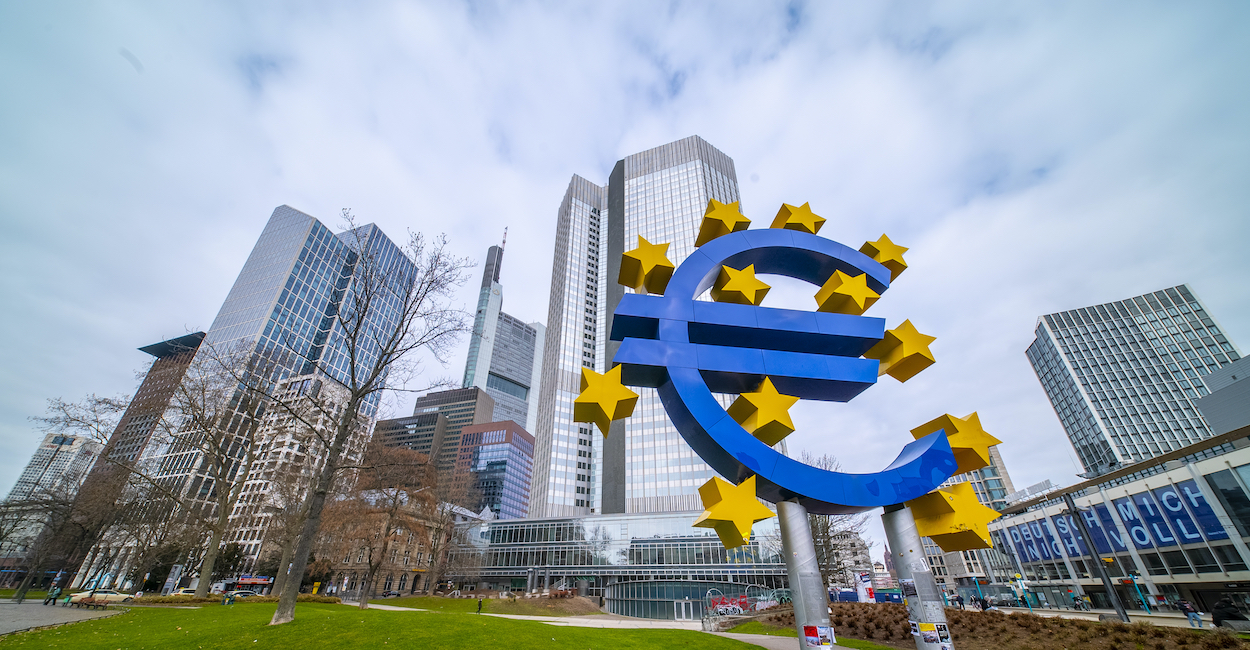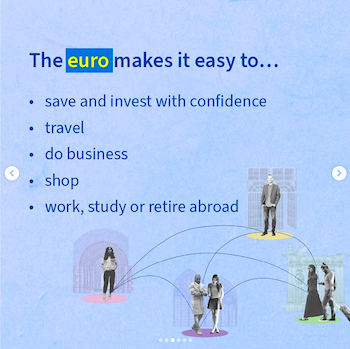How the EU elite let the Euro down, and not vice versa
By Bob Lyddon – 4 minute read
TWENTY-FIVE years on and the Euro’s benefits have been reduced to stunning banality in this promotional graphic below, issued by the Council of Europe to mark the Silver Anniversary of the Euro’s existence.
This debasement, issued by one of the main organs in the EU financial-political complex, contrasts sharply with the promises at the currency’s launch, exemplified in the speech by the first President of the European Central Bank (ECB), Dr Wim F Duisenberg, at the Economic Strategy Institute’s Global Economy conference in Washington DC, on 27 April 1999.
The European Union’s authorities now leads with the benefits of eliminating foreign exchange risk and volatility, and reducing transaction costs for trading within the EU – yet the original level of ambition was far higher. Let us recall the EU’s aim was to create an economic zone on a par with the USA, no less: dynamic, innovative, and high-growth.
The euro would not deliver this on its own. It was the co-enabler, with a single monetary policy, of price stability and deep, integrated financial markets meant to accompany it.
– Price stability would both reduce investment risk and cause comparability of prices across the EMU area, breaking down protective barriers, and increasing competition and efficiency – all drivers for economic growth and lower prices.
– Lower prices and better products and services would create value and wealth for private and business buyers of those products and services.
– Deep and integrated financial markets would deliver lower long-term interest rates, reduce the premia built into those rates for credit risk and liquidity risk, and stimulate the allocation of resources towards profitable and productive investments.
Dr Duisenberg’s key point was that the Euro was not an end in itself, and would not automatically deliver the potential benefits. These would depend upon what the single monetary policy was, and on the implementation of policies to shape a ‘macroeconomic environment conducive to stability, growth and employment’, and to ‘foster structural change which is needed to maintain or restore medium to long-term dynamism in the European economies’.
Much needed to be done around labour market policy, and on the fiscal side the medium-term objective should be a budgetary position close to balance or in surplus.
The Maastricht Convergence Criteria had been designed as a common minimum starting point for Euro entry, with ongoing budget discipline deriving from adherence to the Stability and Growth Pact to ensure that ‘price and fiscal stability remains the cornerstone of EMU’.
Where did it all go wrong?
The EU financial-political complex preferred a path of least resistance.
Countries tightened their belts to meet the Maastricht Convergence Criteria upon entry, and loosened their belts afterwards, failing to adhere to the Stability and Growth Pact, and latterly the Fiscal Stability Pact.
Member states have rarely achieved a budgetary position either in balance or positive. A monetary policy set by the ECB characterised by low interest rates – particularly for member states accustomed to far higher rates in their legacy currencies – fuelled a credit and real estate boom, and led to the insolvency of Ireland, Portugal, Cyprus and Greece, and a banking system full of bad loans. Price stability went out of the window.
The tone of fiscal policy subsequent to the Eurozone Sovereign Debt Crisis was set by Francois Hollande and Angela Merkel, and their policy of using the European Investment Bank as a channel for countercyclical public spending, notably through the European Fund for Strategic Investments.
This pattern was continued by the EU’s Coronavirus Recovery Fund: borrowing through European supranational entities or off-balance-sheet schemes that enable spending to continue but to bypass the figures for the fiscal balance and the ‘General government gross debt’ at the member state level, upon which the controls operate.
The money keeps flowing, and the controls are sidestepped.
Fiscal deficits appear to improve. Member state debt appears lower because the member state is liable for the additional debt without borrowing it itself: a contingent, off-balance-sheet liability is incurred instead of a real, on-balance-sheet liability.
GDP is boosted by the borrowed money being spent, bogusly improving the Debt-to-GDP ratio because the increase in debt is not recognised. Member state compliance with the Stability and Growth Pact and the Fiscal Stability Pact is overstated.
No meaningful fiscal reform has occurred. Public budgets and debt levels are flattered by accounting techniques. The creation of these workarounds causes the public sector to be involved in an ever-growing portion of economic activity. The public sector expands while the private sector dwindles.
Dynamism, competition, innovation are not restored into the European economy, as Dr Duisenberg hoped. Instead, intervention, regulation, protectionism and bureaucracy set in, generating stagnation.
Can the Euro’s promises still be fulfilled? Only by a monumental change of direction and act of will, and one alien to the EU financial-political elite whose careers are built on the current system of public economic intervention and patronage.
If you appreciated this article please share and follow us on Twitter here – and like and comment on facebook here. Help support Global Britain publishing these articles by making a donation here.
Bob Lyddon is an independent financial analyst specialising in international and central banking.
Photo of Euro currency sculpture in Willy Brandt Square, Frankfurt, by 4kclips from Adobe Stock


